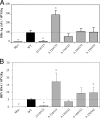The translocation motif of hepatitis B virus envelope proteins is dispensable for infectivity
- PMID: 17494068
- PMCID: PMC1933348
- DOI: 10.1128/JVI.00224-07
The translocation motif of hepatitis B virus envelope proteins is dispensable for infectivity
Abstract
The early events of hepatitis B virus (HBV) infection remain unclear. In 2006, Stoeckl et al. proposed a new entry mechanism involving a translocation motif (TLM) present in the pre-S2 domain of envelope proteins (L. Stoeckl, A. Funk, A. Kopitzki, B. Brandenburg, S. Oess, H. Will, H. Sirma, and E. Hildt, Proc. Natl. Acad. Sci. USA 103:6730-6734, 2006). After receptor binding and internalization into the endosomal compartment, this motif would allow the translocation of HBV particles through the endosomal membrane into the cytosol. In this study we have used two different mutated viruses containing a truncated TLM and showed their ability to infect human hepatocytes in primary culture, thus demonstrating the dispensability of the TLM for HBV infectivity.
Figures



Similar articles
-
Infectivity determinants of the hepatitis B virus pre-S domain are confined to the N-terminal 75 amino acid residues.J Virol. 2007 Jun;81(11):5841-9. doi: 10.1128/JVI.00096-07. Epub 2007 Mar 21. J Virol. 2007. PMID: 17376925 Free PMC article.
-
Two potentially important elements of the hepatitis B virus large envelope protein are dispensable for the infectivity of hepatitis delta virus.J Virol. 2007 Apr;81(8):4343-7. doi: 10.1128/JVI.02478-06. Epub 2007 Jan 24. J Virol. 2007. PMID: 17251287 Free PMC article.
-
Myristylation of the hepatitis B virus large surface protein is essential for viral infectivity.Virology. 1995 Nov 10;213(2):292-9. doi: 10.1006/viro.1995.0002. Virology. 1995. PMID: 7491754
-
Virus entry mediated by hepatitis B virus envelope proteins.World J Gastroenterol. 2013 Oct 28;19(40):6730-4. doi: 10.3748/wjg.v19.i40.6730. World J Gastroenterol. 2013. PMID: 24187448 Free PMC article. Review.
-
Envelopment of the hepatitis B virus nucleocapsid.Virus Res. 2004 Dec;106(2):199-209. doi: 10.1016/j.virusres.2004.08.016. Virus Res. 2004. PMID: 15567498 Review.
Cited by
-
The first transmembrane domain of the hepatitis B virus large envelope protein is crucial for infectivity.J Virol. 2009 Nov;83(22):11819-29. doi: 10.1128/JVI.01026-09. Epub 2009 Sep 9. J Virol. 2009. PMID: 19740987 Free PMC article.
-
The pre-s2 domain of the hepatitis B virus is dispensable for infectivity but serves a spacer function for L-protein-connected virus assembly.J Virol. 2010 Apr;84(8):3879-88. doi: 10.1128/JVI.02528-09. Epub 2010 Feb 3. J Virol. 2010. PMID: 20130049 Free PMC article.
-
HBV life cycle: entry and morphogenesis.Viruses. 2009 Sep;1(2):185-209. doi: 10.3390/v1020185. Epub 2009 Sep 1. Viruses. 2009. PMID: 21994545 Free PMC article.
-
Initiation of duck hepatitis B virus infection requires cleavage by a furin-like protease.J Virol. 2010 May;84(9):4569-78. doi: 10.1128/JVI.02281-09. Epub 2010 Feb 24. J Virol. 2010. PMID: 20181690 Free PMC article.
-
Hepatitis B and D virus entry.Nat Rev Microbiol. 2025 May;23(5):318-331. doi: 10.1038/s41579-024-01121-2. Epub 2024 Nov 21. Nat Rev Microbiol. 2025. PMID: 39572840 Review.
References
-
- Aden, D. P., A. Fogel, S. Plotkin, I. Damjanov, and B. B. Knowles. 1979. Controlled synthesis of HBsAg in a differentiated human liver carcinoma-derived cell line. Nature (London) 282:615-616. - PubMed
-
- Berting, A., C. Fischer, S. Schaefer, W. Garten, H. D. Klenk, and W. H. Gerlich. 2000. Hemifusion activity of a chimeric influenza virus hemagglutinin with a putative fusion peptide from hepatitis B virus. Virus Res. 68:35-49. - PubMed
Publication types
MeSH terms
Substances
LinkOut - more resources
Full Text Sources

